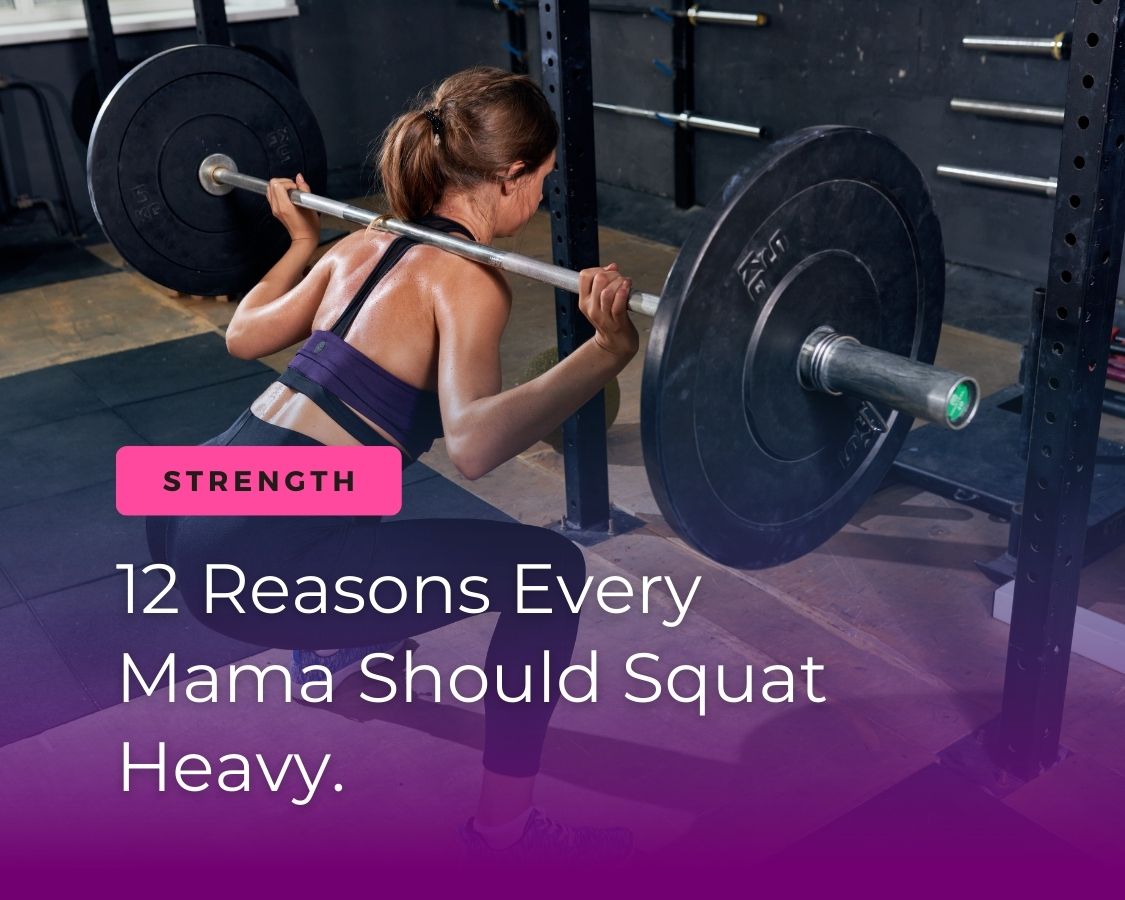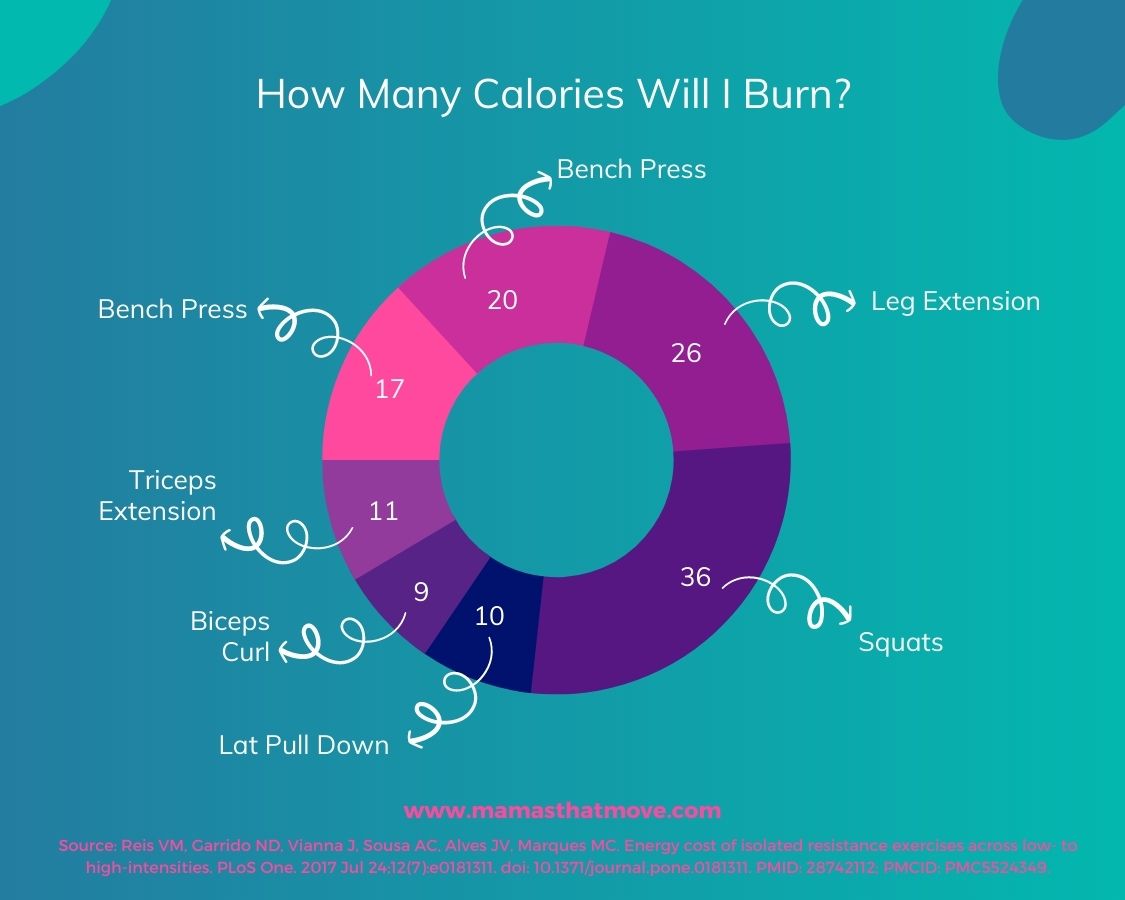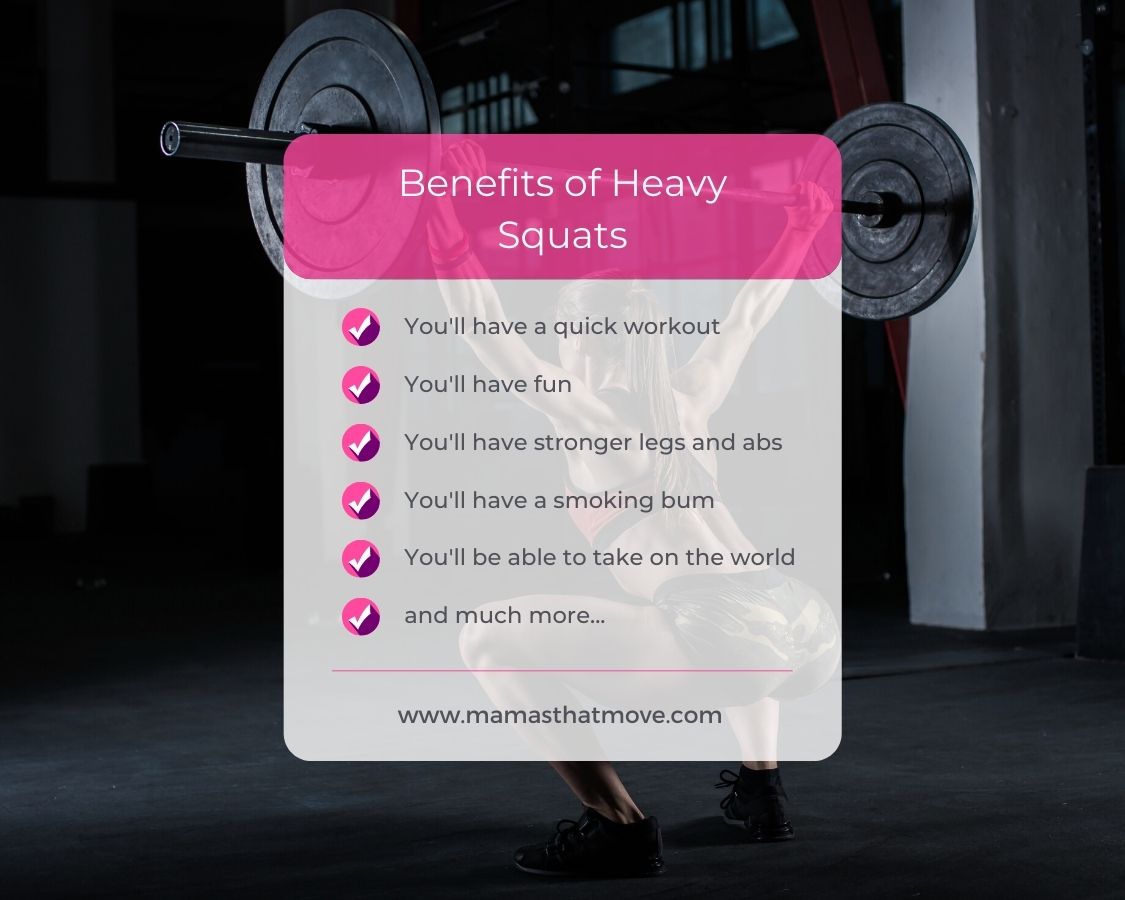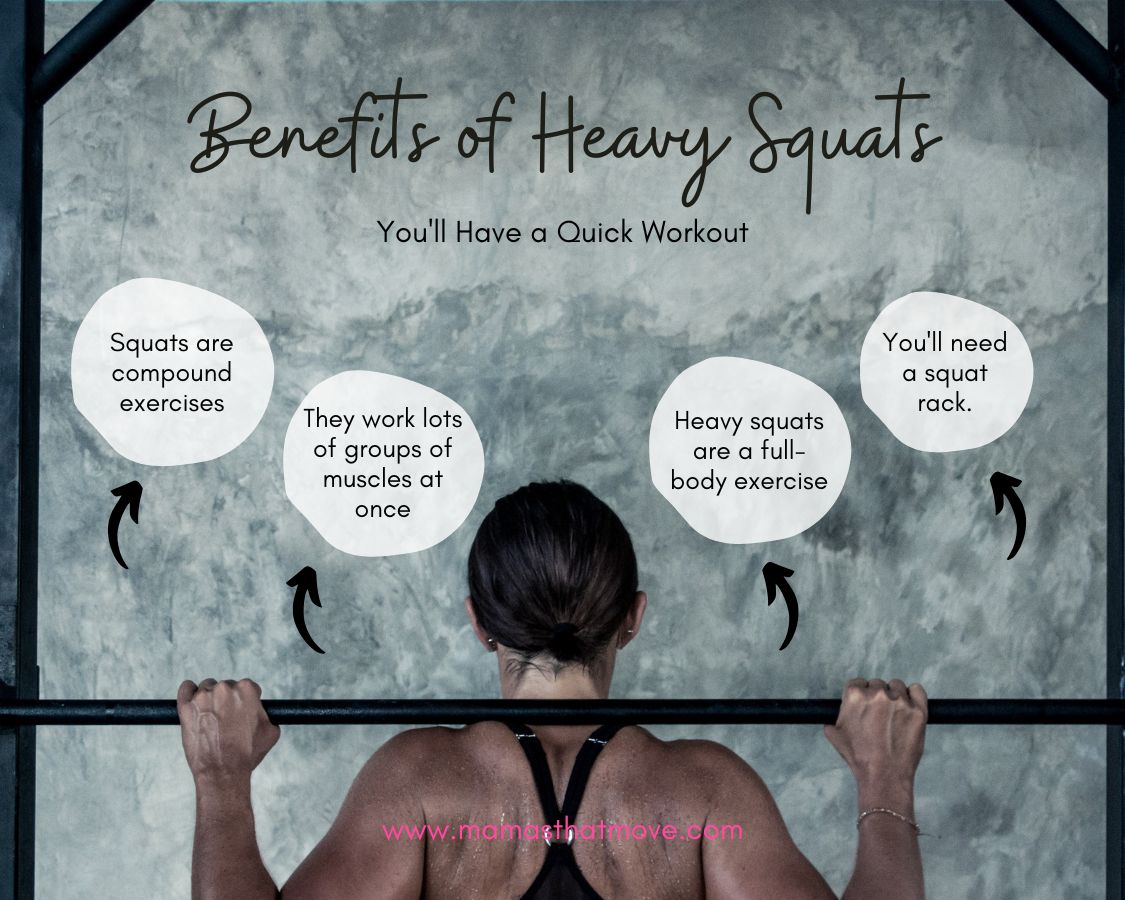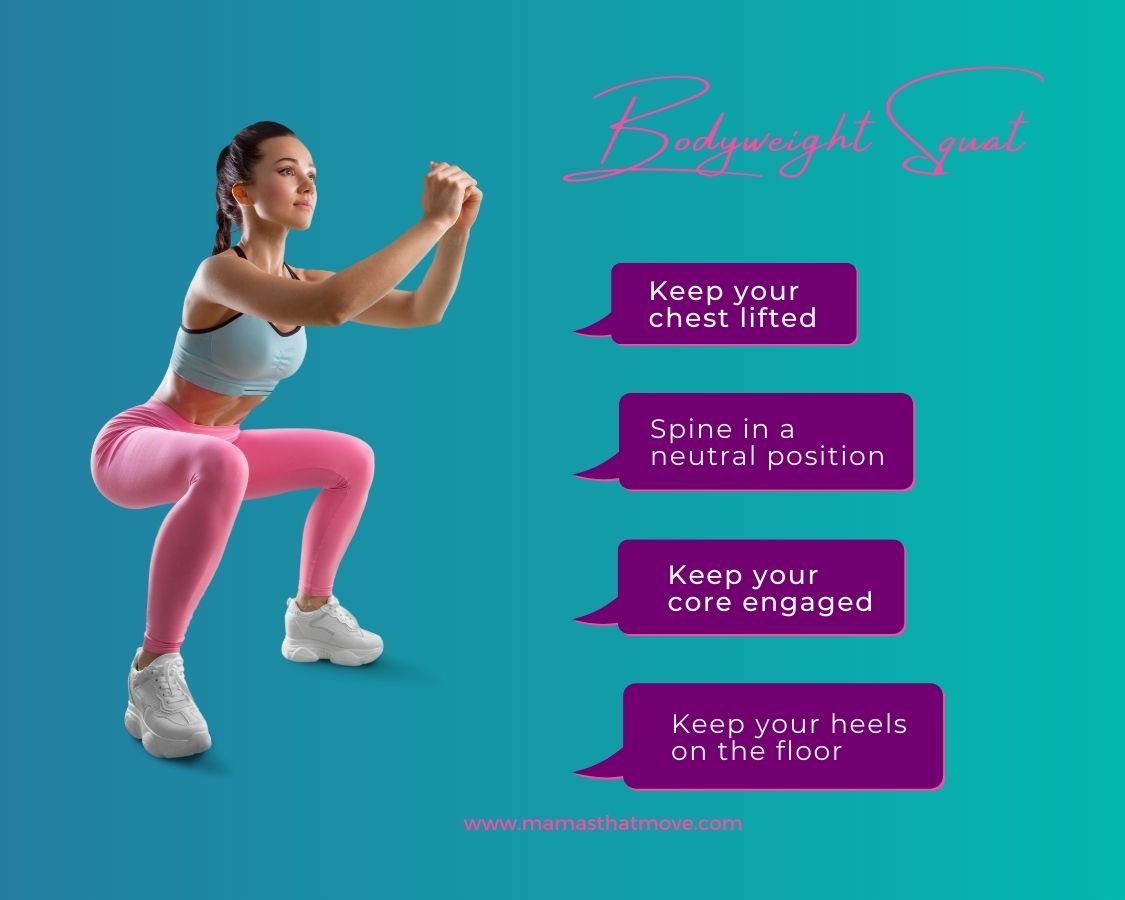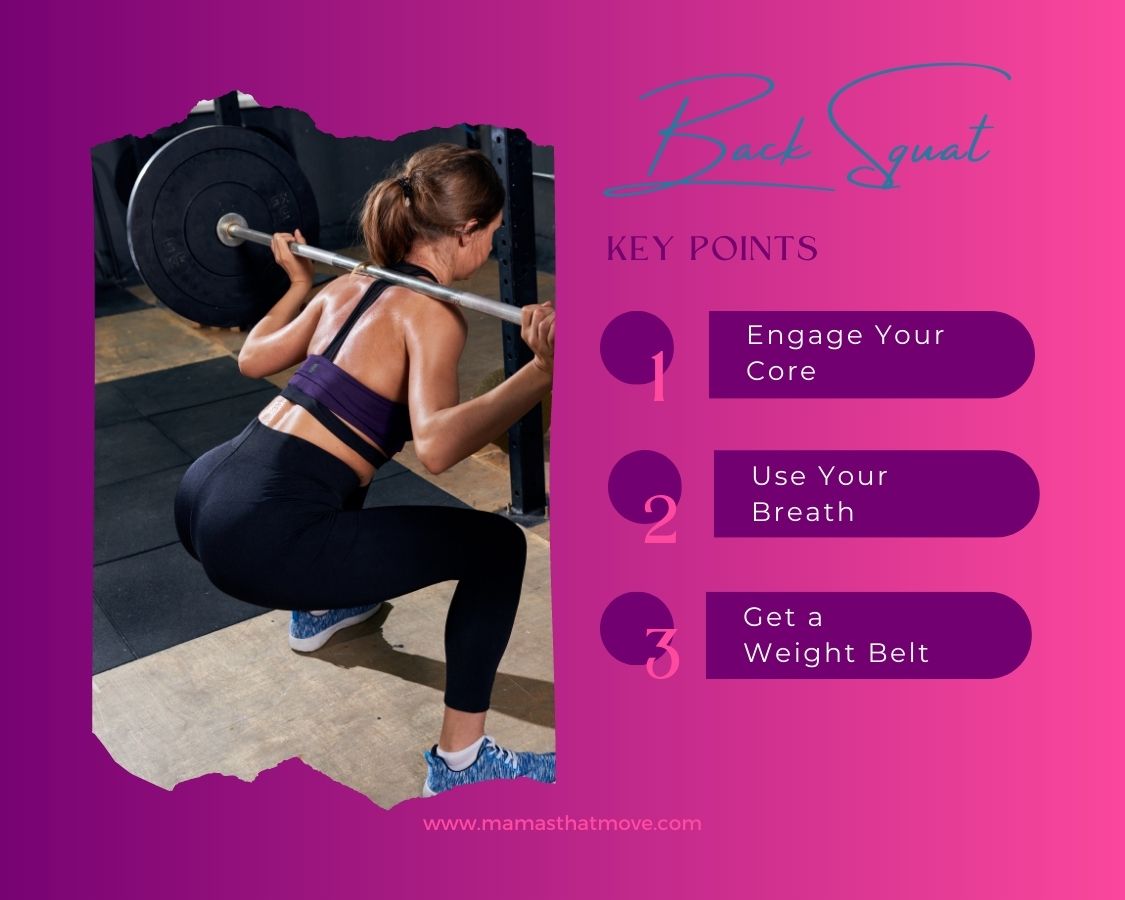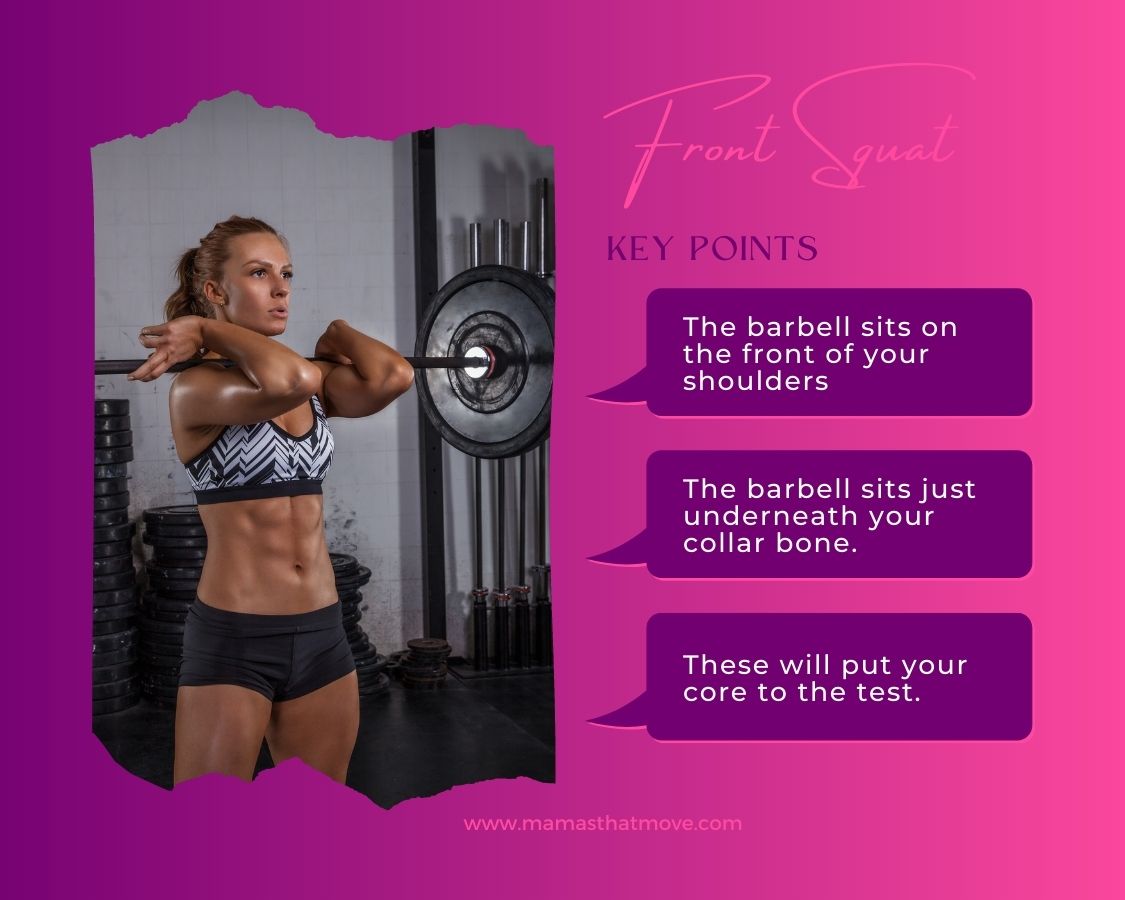- Home
- Strength Training for Women
- Benefits of Heavy Squats
Benefits of Heavy Squats: 12 Reasons Every Mama Should Squat. Heavy.
The benefits of heavy squats are numerous. But here are 12 that I think you’ll be interested in. Spoiler alert, they’re quick and very very effective.
Beth's 1 Week Meal Plan

Do you want an efficient, yet very effective workout?
One that isn’t
complicated.
One that doesn’t
take a great deal of time and will have you meeting your goals,
whatever they are?
Of course you do.
Then make sure
you’re doing heavy squats.
Why?
I’ve got 12 great
reasons that I think you’ll be interested in...
1. Benefits of Heavy Squats: You’ll Keep Up With Your Kids
As I mentioned
above, heavy squats will help your mobility. They will help you move
around pain free. As you get stronger and more flexible in those
joints.
But they also help
you become more powerful in a vertical jump and running.
You might be
thinking, “why the f**k do I need to be more powerful in a vertical
jump. I don’t need to jump, I’m not doing athletics.”
Well, how about
this…
You’re at a park.
You’re sat on the floor. That’s where I usually sit anyway.
Because inevitably there are no benches where my little girl wants to
play.
So you’re sat on
the floor, happily watching your kids on the trampoline and then they
decide they want to go on the swings.
So, off they run and
you’ve got to get up really quickly to stop them before they run in
front of the swings.
Heavy squats will
help with that movement. Getting off the floor and quickly into a
dynamic movement.
Just imagine what else you could do if that kind of movement was easier, more powerful, less painful. What other daily activities would be easier?
2. Benefits of Heavy Squats: You’ll Have Fun
You might take a bit
of convincing with this one, but honestly squatting heavy is so much
fun.
There is something
very powerful, very primal about piling weights onto a bar. Getting
the bar on your back and then sinking down for the squat.
And you’ll be
surprised how many jaws drop when those weights start to get heavy.
And they will get
heavy. And they’ll get heavy pretty quickly.
You’ll get the
bug.
How much can I squat
now? Can I get another PB (personal best)? How many can I do?
It won’t be long
before you’re itching to get back into the gym and back under the
bar.
Heavy squats are
fun. They’re challenging. They’ll get your competitive juices
flowing.
So don’t squat light, squat heavy.
3. Benefits of Heavy Squats: You’ll Lose Weight
I don’t know about
you, but weight loss has to be the top goal of my clients.
If you’re the
same, heavy squats will definitely help you with this goal. I’ve
talked about losing weight with strength training in some detail, but
squats are particularly good for reducing your body fat.
A study was
conducted into the calorie burning effects of different exercises.
The study compared leg press, leg extensions, bench press, lat
pull-down, bicep curl and triceps extension and the squat came out the
queen.
For comparison
squats burn around 35 calories per minute whereas a minute on a
treadmill burns between 5 and 9 calories.
So, if you want to lose weight or improve your body composition, then add some heavy squats to your workout routine.
4. Benefits of Heavy Squats: You’ll Keep Mobile
To squat heavy you
need strength, but you also need flexibility. And both of these are
essential for mobility.
If you think about
it, when you descend into a squat you’re flexing at your hips, your
knees and your ankles. If you’re tight in any of those joints, you
won’t be able to descend very far into a squat.
The trick to getting
your full range of motion back is to keep squatting.
Aim to get into a
deep squat position. Ass to grass baby. And as you do, you’ll be
getting more flexible and stronger.
More mobile.
Being more mobile,
essentially being able to move pain free, is a huge benefit of
squats, particularly heavy squats.
But, if you are struggling to do a deep squat properly, don’t immediately add in weight. Work on your technique and addressing any imbalances you may have.
Once the movement feels easier, then you can work on getting stronger in that movement and your joints.
5. Benefits of Heavy Squats: You’ll Have a Smoking Bum
This is the one
we’re most interested in. Am I right?
Squats are a great
exercise to work your bum muscles. Your gluteus maximus, gluteus
minimus and gluteus medius. A squat works them all.
They strengthen,
they firm, they sculpt. In short, heavy squats will give you an
awesome looking butt.
And with just one
exercise.
What more could you want?
6. Benefits of Heavy Squats: You’ll Have Strong, Toned Legs
But, squats don’t
just work your glute muscles. They work your leg muscles as well.
Your quadriceps,
your hamstrings, your hip flexors.
Squats help to
strengthen them all. And the result?
You have strong
legs.
And when your legs
are strong, they’re firm and toned and sculpted.
I can’t say they’ll be cellulite free. That requires more than just squats, I’m afraid. I think you know what I’m going to say...you need a healthy, balanced diet as well.
So, no I can’t guarantee that your legs will be cellulite free, but I can guarantee they’ll be strong.
7. Benefits of Heavy Squats: You’ll Have a Rock Hard Core
As I mentioned above
in point, let me check...oh, it was the second one, the regular squat,
or an air squat for any CrossFitters, will sky rocket your lower body
strength.
Body weight squats
are primarily, not exclusively but primarily lower body exercises.
But, when you add in
weights, whether that’s free weights, barbells, resistance bands,
you start to recruit your upper body muscles and your core muscles.
You’re core
muscles are recruited to help stabilise you. To stop you toppling
over under the heavy weight.
Core strength is
needed to keep you upright.
So, if you want a
strong core do some heavy squats.
You’ll also get strong legs and a sculpted bum, so that can’t be bad.
Benefits of Squats
8. Benefits of Heavy Squats: You’ll have a Better Posture
When you squat with
heavy weights you have to be really conscious about squatting with
good form.
That means keeping
your chest lifted, your spine neutral and your lower back engaged.
You become more
aware of hunching over.
The thing is, when
you hunch the muscles in your back, well all of your posterior chain,
become elongated and weaker. And the muscles on the front of your
body become shorter and tighter.
By strengthening the
muscles in your back and stretching the muscles on the front of your
body, keeping your chest lifted, you’ll have the cornerstones for
better posture.
You’ve also got to make a conscious effort to stop hunching, so sitting properly etc, but you’ll have the cornerstone for it.
9. Benefits of Heavy Squats: You’ll Reduce Your Risk of Injury
Bone density is
something all of us ladies should be mindful of.
As we age and our
oestrogen levels start to decrease and so does the density of our
bones. That increases our risk of brittle bones.
Bones that are prone
to breaking if we fall.
Squatting with heavy
weights will not only build your muscles, it will build your bones as
well.
Stronger muscles
means you’re less likely to fall in the first place and if you do,
your stronger bones will mean they’re less likely to break.
Add to that you’ll
be more mobile and more flexible and your risk of injury falls,
drastically.
So, for injury prevention, squat heavy.
10. Benefits of Heavy Squats: You’ll have a Quick Workout
Squats are what you
call a compound exercise.
That means they work
more than one muscle group. In fact squats work quite a few muscle
groups.
The primary muscles
that bodyweight squats work are your lower body muscles. Your quads,
your glutes, your calves. But when you add in weight, particularly a
heavy weight, you start working your upper body and your core as
well.
That makes heavy
squats a full body exercise.
And when you can
work your entire body with just one movement, that makes a really
quick workout.
And that’s what we
need as busy mamas, don’t we?
So, if you’re stuck for time, stick to heavy squats and you won’t go far wrong.
11. Benefits of Heavy Squats: You’ll Have Less Painful Joints
It’s a common
misconception that heavy squats cause knee pain.
In fact, they
actually do the opposite.
Most people’s
knees hurt because the knee joint is doing a job, or taking a strain
they’re not designed to do. That happens when leg muscles are weak
and can’t do their job properly.
It’s a similar
problem with lower back pain. Although, it’s generally not through
weak legs.
With lower back it’s
usually because you’ve got weak gluteus muscles.
Squats do lots of
things well, but increasing leg strength and bum strength is kind of
what they’re known for.
So, if you’re suffering from lower back pain, or knee pain, visit your doctor first and then, if you’re given the all clear, try some squats.
12. Benefits of Heavy Squats: You’ll Take on the World
There is a general
correlation between squat strength and overall strength.
And when you feel
strong physically, you feel stronger emotionally. You feel stronger
in your everyday life.
There is something
incredibly empowering about stacking your weight, kilogram by
kilogram onto a barbell. Getting under the bar, setting up and then
squatting the whole bloody lot.
You literally do
feel like you can take on the world.
Tantrums from your
three year old, no longer bother you.
Demands for food
that they’ll never eat, ah well.
Heavy squats are incredibly empowering.
Benefits of Heavy Squats: How to Do a Squat
Ok, before you start
squatting heavy, I want to make sure you know how to do a squat with
proper form.
It’s really,
really important that you perfect your squat technique before you add
weight. If you don’t you will just get injured.
As always I’m going to suggest you seek advice from a personal trainer. And if you can’t find one locally, then do get in touch. We can arrange a virtual coaching session.
What is Proper Squat Form?
Ok, so we’re going to concentrate on the correct form for a bodyweight squat and build on that.
The starting position is standing with feet hip-width apart.
Using your breath is really helpful during heavy squats. So, practice it with bodyweight squats. It will then be second nature when you add weight.
Take a deep breath in and hold it as you flex at your hips, knees and ankles.
Sink your bum back and down until your knees are at least parallel to the floor. If you can go lower, without hurting yourself then do.
As you push back up through your heels, breathe out and come back to the standing position.
During all phases of the squat, make sure your chest is lifted, your spine is in a neutral position and your core is engaged. And your feet, all of your feet should remain firmly on the floor. If your heels are raising you’re lacking flexibility somewhere. You need to work on that before you add any weight.
Your breath will help engage your core.
Benefits of Heavy Squats: Squat Variations
Once you’ve got the bodyweight squat mastered, you can try a few of the other variations and start to put together a little workout.
Back Squat
A back squat is when
there is a barbell on your back. It is generally done with a barbell
because I don’t think there is any other form of weight you could
hold on your back while squatting.
If I’m wrong do
let me know.
Key points to
remember, keep your core engaged. Use your breath. As you get heavier
you might want to invest in a weight belt.
You will need a
power rack or squat rack.
As you use heavier
weights you’ll struggle to get them onto your back on your own. You
will need something to hold the barbell in place while you get set
up.
Goblet Squat
A goblet squat is
where you hold a dumbbell or kettlebell at chest height whilst you
squat.
The technique is
exactly the same as a regular squat, but you obviously have to get
the dumbbell or kettlebell into position before you start the squat.
You do that by a
technique called cleaning.
You won’t be able to squat as heavy weights as you can with a back squat. But they are just as effective.
Front Squat
This is another
barbell squat but instead of setting it up on the back of your
shoulders you set it up on the front of your shoulders.
So the barbell would
sit just below your collar bone.
This can be a
heavier squat, but again not as heavy as a back squat.
Your core is going to be put to the test with this squat exercise as the weight tries to pull you over.
Benefits of Heavy Squats: How Heavy Can You Go?
In conclusion,
squats are a great thing. The benefits of squats are plenty. But when
you add weight, heavy loads to this classic exercise, the benefits
multiply.
Squatting with a
heavier weight will make sure you’re seeing the benefits quickly
which will keep you motivated to carry on.
So, don’t be
afraid of a barbell, or shy away from the weight.
See exactly what
you’re capable of. Squat heavy.
If you want fun and
quick home workouts delivered straight into your inbox then remember
to sign up for my newsletter.
Get Your Ultimate Free Eight Week HIIT Workout Plan
Get fitter, stronger and leaner in just eight weeks with my printable HIIT workout Plan. Just 30 minutes a day is all you need.
Want to know more before you sign up?
Check out Printable HIIT Workout Plan to learn all about the plan, what's involved and why you should get it.
What are the benefits of heavy squats?
What are the benefits of heavy squats?
- You’ll Keep Up With Your Kids
- You’ll Have Fun
- You’ll Lose Weight
- You’ll Keep Mobile
- You’ll Have a Smoking Bum
- You’ll Have Strong, Toned Legs
- You’ll Have a Rock Hard Core
- You’ll have a Better Posture
- You’ll Reduce Your Risk of Injury
- You’ll have a Quick Workout
- You’ll Have Less Painful Joints
- You’ll Take on the World
What different types of squats are there?
What different types of squats are there?
Squats come in all shapes and sizes.
The most popular heavy squat is the back squat. It's done, usually, with a barbell.
It's popular because, with the bar on your back you can squat heavy weights.
What will you need for heavy squats?
What will you need for heavy squats?
You will need weights of some description.
Whilst you can get a pretty good workout just using your own bodyweight, if you're interested in squatting heavier you will need to invest in weights.
If you're working out at home free weights are the best option, rather than a leg press or leg extension machine because they are much more versatile.
As you get heavier, you will need a power rack, also known as a squat rack.
What do I if i can't squat?
What do I if i can't squat?
Squatting is a great exercise, but it does take a lot of flexibility.
If you're not there yet leg raises are a great alternative. They help build up strength and mobility in your lower body.
Keep working on those until you're able to squat with good form.
